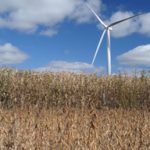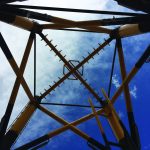Pattern Energy, an independent renewable energy company, recently entered into an agreement to fund extensive new research by Bird Conservancy of the Rockies to study birds associated with piñon-juniper woodlands in New Mexico. Pattern Energy’s $80,000 contribution will support scientific monitoring of the potential impacts from management activities on the pinyon jay and other declining birds associated with piñon-juniper woodlands.
Pattern Energy is developing the Western Spirit Wind Projects, collectively the largest single-phase wind project in the United States, in central New Mexico, where the landscape is typified by a mosaic of piñon-juniper woodlands and savannas. The contribution comes from financial agreements for four wind energy projects: Clines Corners Wind Farm LLC, Duran Mesa LLC, Red Cloud Wind LLC, and Tecolote Wind LLC (collectively, the “Western Spirit Wind Projects”).
“The pinyon jay has suffered an 85 percent decline in population since the 1960s and is predicted to lose an additional 50 percent% of its population by 2035,” said Carol Beidleman with Defenders of Wildlife in Santa Fe. “This research will be absolutely vital to protecting this vulnerable species and its habitat.”
“Along with the loss of over a million pinyon jays, many other bird species dependent on piñon-juniper woodlands, such as the juniper titmouse, have also declined significantly,” she said. “The situation is dire, but thanks to strong support from Pattern Energy, there will be reliable science to guide land management projects to better protect this vulnerable habitat and the bird species that are dependent on it.”
“We have learned from years of conducting extensive avian surveys that state and federal agencies, as well as conservation stakeholders, have expressed a lack of robust data on the current status and vulnerabilities of pinyon jays and we wanted to resolve that,” said Adam Cernea Clark of Pattern Energy. “Given the iconic nature of the pinyon jay and its role as a keystone species in a delicate ecosystem, Pattern Energy wants to build our collective understanding of the species and its habitat in New Mexico.”
Of the iconic landscapes in New Mexico, the most familiar is probably that of the piñon-juniper woodlands. Covering a significant portion of the state, this habitat has always been important to humans, as a source of firewood and the nutritious piñon “nuts,” but also for birds and other wildlife. Without the pinyon jay, however, there would be few new piñon pines. Theirs is a symbiotic relationship, with this beautiful blue jay being the primary consumer, and disperser, of the seeds. It “caches” or buries the seeds, allowing for more successful germination. Many other bird species associated with this habitat are therefore dependent on the pinyon jay, just as we are.
Through a collaboration with Defenders of Wildlife, Audubon Southwest, and The Nature Conservancy of New Mexico, Cernea Clark saw an opportunity to support a new research project focused on piñon-juniper woodlands and their associated bird species in New Mexico.
“What I learned from the conservation community is that the pinyon jay, with its caches of seeds, is the primary means for the piñon pine to expand its distribution,” Cernea Clark said. “We know that ecosystems themselves are migrating in elevation and latitude in response to climate change and piñon-juniper woodlands need this bird to adapt to a changing climate. Pattern Energy’s mission is to transition the world to renewable energy, which we need to mitigate the intensity of climate change. There is an eloquent parallel in this bird’s role in the environment and the role of renewable projects like the Western Spirit Wind Projects.”
Some threats to the pinyon jay are known. Climate change and drought, accompanied by insect outbreaks, have killed many piñon trees. But, less is known about how large landscape management projects, such as thinning for wildfire mitigation and clearing for rangeland improvements, affect this rapidly disappearing bird.
More info patternenergy.com


































